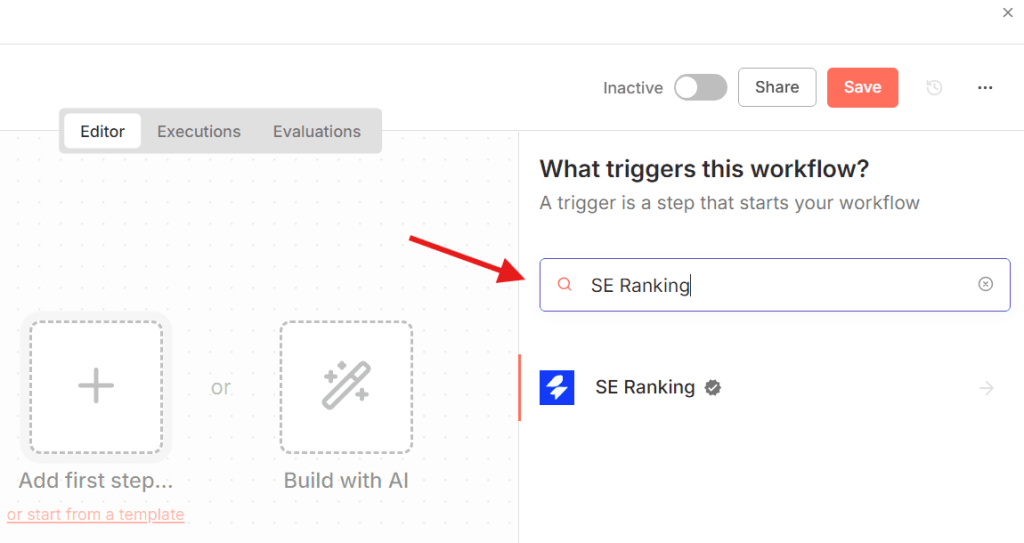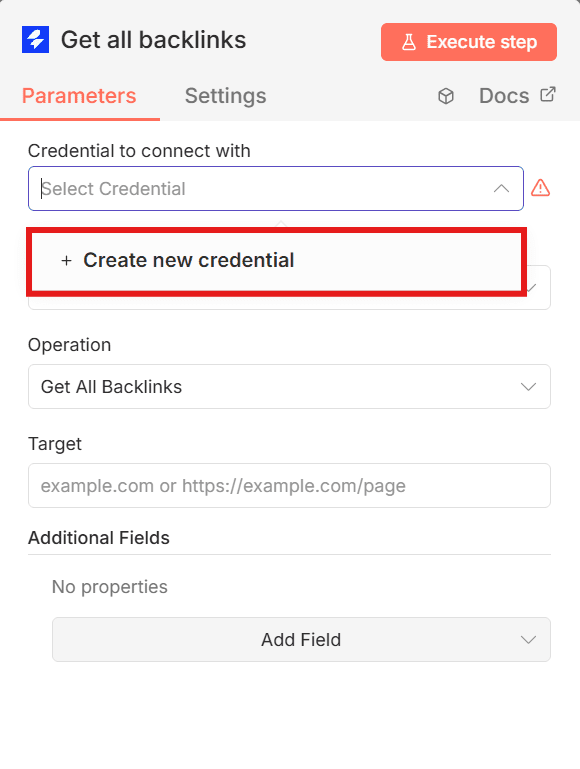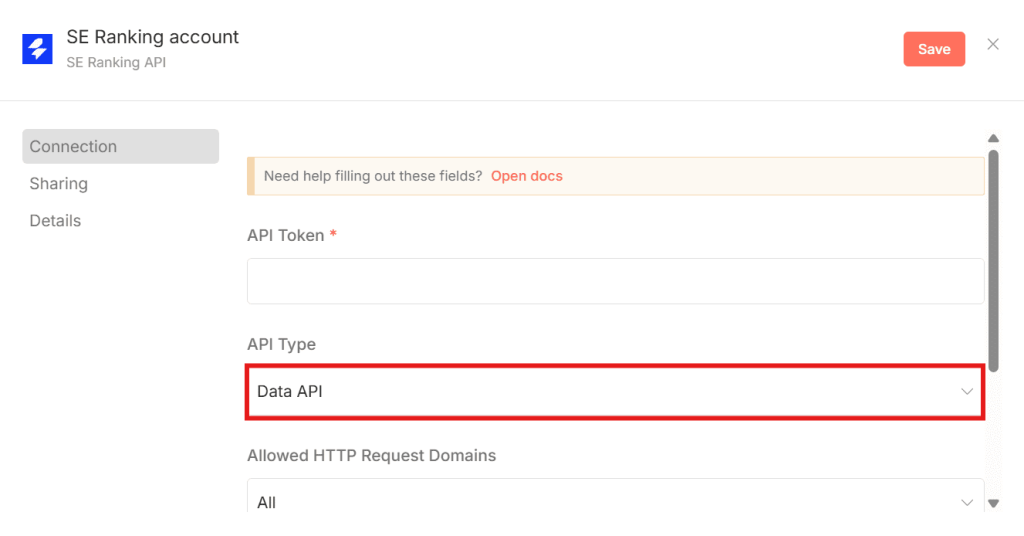n8n
The SE Ranking integration with n8n provides automation of SEO workflows by connecting SE Ranking data to n8n pipelines. It supports access to AI Search data, backlink monitoring and status checks, domain-level SEO analysis, keyword research datasets, SERP results for specific queries, and website audit data.
What is n8n for SEO?
n8n is an open-source automation platform that allows you to connect different apps and services without needing to write complex code. It’s designed to help SEO professionals and businesses automate repetitive tasks, such as data retrieval, reporting, and monitoring, with complete control over their workflows.
This guide provides step-by-step instructions for integrating SE Ranking with n8n both locally and in the Cloud.
- For running n8n locally, see Self-hosted setup.
- For using n8n Cloud, see Cloud setup.
Prerequisites
For self-hosted n8n:
- SE Ranking account with API access
- Node.js 18.x or higher
- n8n 1.0.0 or higher installed locally
For n8n Cloud:
- SE Ranking account with API access
- n8n Cloud account
Self-hosted setup
Step 1. Install n8n
1. If you haven’t installed n8n yet, run the following command in your terminal (ensure you’re using Node.js version 18.x or later):
npm install n8n -g 2. Launch n8n by running:
n8n start Step 2. Install the SE Ranking node
You can install the SE Ranking node using one of the following methods:
Option A: From the n8n interface (recommended)
1. Open http://localhost:5678 in your browser and log in.
2. Go to Settings → Community nodes → Install a community node.

3. In the npm Package Name field, enter @seranking/n8n-nodes-seranking.

4. Click Install and wait for the installation to complete.
Option B: Programmatically via terminal
Install from a .tgz file:
cd [path-to-downloads-folder]
npm install -g seranking-n8n-nodes-seranking-1.3.1.tgz
Install from GitHub:
npm install -g git+https://github.com/seranking/n8n-nodes-seranking.git
Install from source:
cd ~/.n8n/custom
git clone https://github.com/seranking/n8n-nodes-seranking.git
cd n8n-nodes-seranking
npm install
npm run build
npm link
Step 3. Add the SE Ranking node to your workflow
- Once the installation is complete, open
http://localhost:5678in your browser (or return to your n8n tab if it’s already open). You should now see the SE Ranking node in the node selector. - Search for “SE Ranking,” drag it into your workflow, and proceed to configure it.
Step 4. Configure credentials
- In n8n, open the installed SE Ranking node.
- Click Create new credential.
- Enter your API Token.
- Select Data API as API Type.
- Click Save.
Updating the SE Ranking node
To update the SE Ranking node to the latest version, use the same method you used for installation, then restart n8n.
If installed from a .tgz file:
npm uninstall -g seranking-n8n-nodes-seranking
npm install -g seranking-n8n-nodes-seranking-NEW-VERSION.tgzIf installed from GitHub:
npm install -g git+https://github.com/seranking/n8n-nodes-seranking.gitIf installed from source:
cd ~/.n8n/custom/n8n-nodes-seranking
git pull
npm install
npm run buildCloud setup
Step 1. Log in to n8n
Log in to your n8n Cloud account at https://app.n8n.io. Open your workspace or create a new workflow.
Step 2. Add the SE Ranking node
1. Click the + to add a new node.
2. Search for SE Ranking in the node list:

3. Click the desired SE Ranking action from the list to add it to your workflow.
Step 3. Configure credentials
1. In the Parameters tab inside the node action, select + Create new credential:

2. In the window that opens, enter your SE Ranking API token.
3. Select Data API as API Type:

4. Click Save.
Start building workflows with the node. For more information, see Creating workflows below.
Creating workflows
Once the SE Ranking node is set, you can start building custom workflows.
Step 1. Create a new workflow
1. In your n8n dashboard, click Create workflow in the top right corner.
2. Search for SE Ranking in the node list.
3. Add it as your first node or as part of an existing automation chain.
Step 2. Choose an operation
Each SE Ranking node corresponds to a specific API category. Use the Operation dropdown to select the specific API action you want to perform, for example: Discover Brand, Get Prompts by Target, or Get Prompts by Brand.
Step 3. Configure parameters
Enter the required fields and optional filters in the Parameters tab for the selected operation. Common fields include Resource, Domain, Engine, Source, Type, etc.
Step 4. Execute nodes
Click Execute step to test the output and verify the operation works as expected.
Usage example: Automating website audits
You can use the SE Ranking node in n8n to automatically run technical SEO audits on your website, retrieve results, and monitor site health over time.
Step 1. Import the workflow
1. Download the workflow file Website-Audit-Technical-SEO-Monitor.json from this GitHub folder.
2. In n8n, open your workspace or create a new workflow.
3. Click the three dots in the top right corner → Import from File, then select the downloaded JSON.
Step 2. Configure credentials
1. Open any SE Ranking node.
2. Click Create new credential.
3. Enter your API Token and select Data API as API Type.
4. Click Save.
Step 3. Customize audit settings
In the Create standard audit node, adjust parameters such as:
{
"domain": "yourdomain.com",
"title": "Weekly SEO Audit",
"settings": {
"max_pages": 1000,
"max_depth": 10,
"source_sitemap": 1,
"source_site": 1,
"check_robots": 1
}
} Step 4. Set a schedule
Replace Manual Trigger with Schedule Trigger to automate the audit (for example, every Monday at 2:00 AM).
Step 5. Monitor and retrieve results
The workflow includes these key components:
- Create Audit – starts a standard or advanced crawl.
- Monitor Crawl Progress – checks if the audit is complete.
- Get Audit Report – retrieves results and issue breakdowns.
The workflow returns:
- Health score (0–100)
- Total errors, warnings, notices
- Issue details by category (Security, Crawling, Content, Links, etc.)
- Page lists per issue (e.g., broken links)
Example audit report summary
🌐 WEBSITE AUDIT REPORT
Domain: www.example.com
Date: October 30, 2025
Pages Crawled: 1,009
📊 OVERALL HEALTH SCORE: 80/100
🔴 ERRORS (346)
- 4XX HTTP Status Codes: 28 pages
- Broken Internal Links: 45 pages
- Missing H1 Tags: 12 pages
- Duplicate Titles: 143 pages
- Slow Loading Pages: 118 pages
⚠️ WARNINGS (979)
- Missing Meta Descriptions: 234 pages
- Long Titles: 156 pages
- Images Without Alt Text: 589 pages
ℹ️ NOTICES (3,915)
- External 3XX Redirects: 234 links
- Large CSS Files: 880 pages
- Long H1 Tags: 19 pages
✅ PASSED (77 checks)
📈 DOMAIN METRICS
- Google Index: 1,380 pages
- Total Backlinks: 212,249
- Domain Expiration: 2026-10-30
🎯 TOP PRIORITIES
1. Fix 28 pages with 4XX errors
2. Resolve 45 broken internal links
3. Add H1 tags to 12 pages
4. Optimize 118 slow loading pages
5. Fix 143 duplicate title tags
For full workflow examples (importable JSON files), see Usage examples in the GitHub repository.
Troubleshooting
Below are some common issues you may encounter and how to resolve them. If at any stage you believe your access has been blocked or restricted, contact us at [email protected].
| Issue | Possible cause | Solution |
|---|---|---|
| Authentication errors | Invalid or expired API token | – Verify the domain has data in SE Ranking – Check the domain is indexed/tracked – Try a different source or region – Adjust filters (they may be too restrictive) – Wait 24–48h for new domains – Ensure the keyword has search volume |
| Invalid source/country code | Incorrect or unsupported country code | – Use correct Alpha-2 lowercase codes (e.g., us, uk, de, fr, es, it, ca, au, pl) – Check SE Ranking supports data for the region – Some engines/features may not be available everywhere |
| Domain format errors | Invalid domain format | – Remove http://, https://, or www. prefixes – Remove trailing slashes – Use format: example.com or blog.example.com |
| Empty results | No data returned from SE Ranking | – Add a delay between requests using the Wait node – Reduce workflow frequency – Use batch operations instead of individual requests – Upgrade SE Ranking plan for higher rate limits – Implement exponential backoff retry logic |
| Timeout errors | Request too large or slow | – Lower the limit parameter (e.g., 100 instead of 1000)– Use pagination with offset– Remove history_trend parameter if not needed– Use “Get Worldwide Aggregate” instead of getting all regional databases |
| Too many keywords | Keyword batch exceeds API limit (700) | – Split keyword lists into batches ≤700 – Run multiple node executions – Use keyword suggestion operations first to narrow the list |
| Rate limit errors | Too many API requests sent too quickly | – Add delay between requests using the Wait node – Reduce workflow frequency – Use batch operations instead of individual requests – Upgrade SE Ranking plan for higher rate limits – Implement exponential backoff retry logic |
Useful links
- n8n Community Nodes Documentation – Learn how to install, manage, and update custom n8n nodes.
- SE Ranking n8n GitHub Repository – Access the source code, issues, and updates for the SE Ranking node.
- SE Ranking Usage Examples for n8n – Explore ready-to-import workflow examples and use cases.
